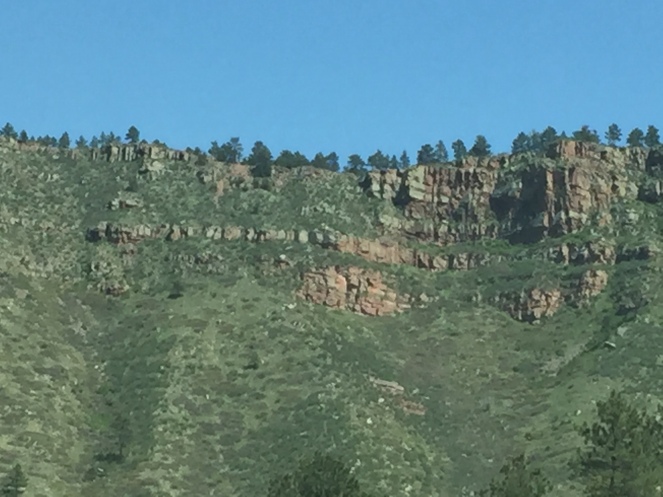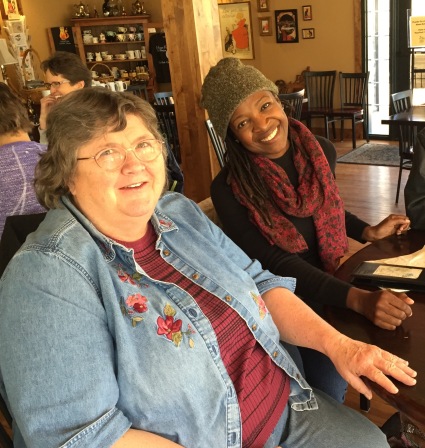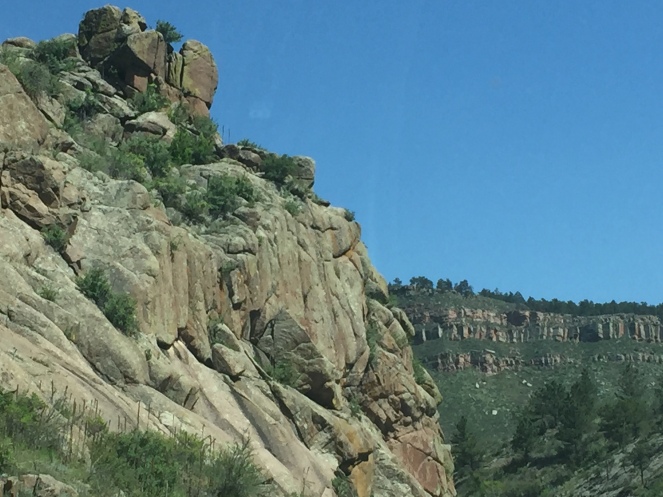
Okay, so the Miami Heat didn’t beat Toronto. I saw as much while waiting in Denver’s airport yesterday. A Lebron-DWade match up would have been nice. Having just had a great time at the 48th Western Association of Women Historians (WAWH) meeting, I was not entirely bummed though. At this conference, I was reminded of the camaraderie felt at JAWS (short for Journalism and Women’s Symposium) back in the 1990s. At the time, I was still a journalist. JAWS always meets out west where the sky indeed appears bigger. The west is also where I see what I call O’Keeffe’s sunsets.
At both JAWS and WAWH, the friendships made give meaning to the work we do. WAWH in particular was the sort of history conference, however, where a scholar opening a fancy box of chocolates will lean over and offer you one. You will be grateful for this, but also with the revelation that the chocolate comes with the giver’s long time friendship with someone you met in Paris years before you ever thought about going back to school.
WAWH is also the place where the closing group dinner invites all present to sing clever lyrics concerning women’s history to the tune of “The Battle of the Hymn of the Republic.” Mention of Linda Kerber is in one of the verses.
WAWH is a place where two historians can have a post-conference chat in a local independent bookstore and do as much wanting earlier conversations to continue. We said goodbye offering to someday swap houses as she wants to know more about the South and I’d love to spend a month in California again.
At the risk of this sounding like a promotional campaign, I will also say WAWH is a place where a historian who is a woman of color can feel the sort of kinship felt as conferences like the Association for the Study of the Worldwide African Diaspora (ASWAD).

Attending this meeting also provided an opportunity to detach altogether. I did as much on a day trip to Estes Park, a town west of Denver. That trip had special meaning because I just finished Roxana Robinson’s Georgia O’Keeffe biography. In it, Robinson discusses O’Keeffe’s visits to Estes Park early last century.
The only other time I had that kind of serendipity, I was traveling more than twenty years ago with a fellow Miami Herald reporter through Brattleboro, Vermont – at the exact same time I was reading May Sarton’s Journal of a Solitude. I was on the very page where Sarton announced she was in Brattleboro when we entered that town.
Colorado’s Clear Creek County archivist Christine Bradley made possible the trip to Estes Park. She took me and colleague John Beeler. There, we had lunch at a tea shop. Bradley is also the co-author of a historical study on Georgetown, Colorado, another town west of Denver. Georgetown was the postbellum home of Charles Osborne Townsend. Townsend, a former enslaved man, appears in Chapter Four of my book Remember Me to Miss Louisa: Hidden Black-White Intimacies in Antebellum America. The book won WAWH’s 2016 Barbara “Penny” Kanner Prize (another reason for the light feeling I presently have).
Osborne, as he liked to call himself, was one of ten children who, along with their immediate kin, was left the equivalent of $5.1 million from his white father, a Huntsville, Alabama, planter. Although they received a fraction of their inheritance, their experiences put on display our messy shared past as I have stated earlier on this blog.

During this conference, I continued to think through the difficulties experienced in sharing this story with wider audiences and received much-needed encouragement from two scholars in particular who regularly do this via blogs and freelance writing. Thank you both.
But I have mostly thought through the discussion had during a panel inviting attention to why “women” as a category still matters. I was forced to retrace my encounters with women’s history in the academy.

The only time I can recall sitting in a class focused primarily on how “woman” is a useful category of analysis was in a course taught by Elizabeth Pleck, University of Illinois Professor Emerita. At the time, I was just a prospective student. The year was 2009.
After being admitted into Illinois’ History doctoral program, I recall being introduced to a lot of literature presenting other labels and concepts. Indeed, I was once interested in “queering” antebellum “mulattos.” I am glad I did not do that. While I see value in such terms, I can see why scholars and students need not discard “woman” or “women” either.
Before attending this WAWH meeting, I had not thought deeply about the possibilities and limitations of using “woman” beyond working on various syllabi though. I have a 75 percent appointment in the University of Alabama’s Department of History and 25 percent appointment in Gender and Race Studies. Sometimes words like “gender” seem to help us reach students with different interests more than the word “woman” does. Indeed, I have been, generally speaking, impressed by the ways in which my students have embraced women’s history. I have worked with even undergraduate students who are drawn to various concepts, among them, “intersectionality.” For example, this was the theme of a paper from a graduating student in my “Bebop to Hip Hop: Young America and Music” class this past spring. She wanted to explore how Janet Jackson sits at the intersection of oppression experienced by both women and people of African descent.
But during the WAWH conference, I found myself wondering if I should assess if this student was a unique case. Should I go back and look at old exams from my “American Civilization to 1865” course and count how many students in a class of more 200 selected the ever-present question on the unique challenges and triumphs of women of varying backgrounds in the early national and antebellum period? That question is always among three from which they get to choose. If memory serves, many of the students choose that question.

Should I assess my upper level undergraduate classes, among them my “Antebellum America” course? In it, students have to read either an excerpt from a captured Union soldier’s diary, or an excerpt from a memoir written by Eliza Potter, a Cincinnati hairdresser of mixed race. Next, they have to pretend to be one of these two historical actors visiting Tuscaloosa’s Drish House, an antebellum mansion. The students do as much while inside this very mansion, which is pictured in the student-produced music video below.
I challenge them to think about the rooms they would be drawn to or want to avoid and for what reasons. Again, if memory serves, most of the students selected Potter. I now wonder if they do so because they were generally familiar with the oppression of antebellum women. Did they do so on the basis of regional loyalties? I do not know.
I teach in a region that produced the southern belle image. So womanhood is not easily discarded as a concept worth studying. That said, sixty five percent of our freshmen are residents of other states. Some of them are from California and Illinois, places that are hardly southern. If these demographics dilute regional attitudes, I do not easily see it.
During the WAWH panel addressing the future of women’s history, “youth culture” was mentioned as being something that influences my students’ ways of seeing. Such a culture includes Beyonce’s feminist politics, something I get to hear a lot about in my “Bebop to Hip Hop” course. Not all agree with Beyonce’s portrayal of her political position though. I recently sat on a Masters committee for a graduate student who is not persuaded (This was before the artist’s Lemonade visual album). I have decided even if this recent graduate is not persuaded, she was engaged and that’s what we want as teachers.
There is much to ponder. A blog post should be no more than 500 words. I haven’t a clue who is still reading (especially with my also ever-present typos. No longer a journalist, I don’t have the benefit of a copy editor and my colleague-husband and I miss a lot for hours, sometimes days or eternally. Ouch). I will try to stop here and simply say the people I met and ideas shared at WAWH will be with me. I hope the same will be true for a graduate student I emailed while in Denver. I rushed to tell her about Sharon Romeo’s study on how black women used military law to claim power in St. Louis during the Civil War.
I was particularly impressed by meeting Kate Aguilar whose dissertation addresses the gender and racial politics faced by African American men who played for the University of Miami’s football team during the program’s rise to prominence during the “Reagan revolution.” While the initial reaction of most scholars looking at the same thing as someone else would be, “Oh no. Not my topic!” mine was “Yay! Someone else is interested in ‘The U’ I have someone to talk to.”

I take this position because of the words of wisdom from my dissertation advisor who said one should never be afraid to share one’s work. The more people you have participating in a conversation, the better. Thank you, WAWH, for reminding me of that.
And now, this eternal Heat fan cannot help but say, “Go, Heat!”
It was such a great conference! And I’m glad to know another U of I Ph.D.
LikeLike
Indeed, Theresa! See you in San Diego next year.
LikeLike